Mega Doctor News
The blockage of lung arteries by a blood clot results in pulmonary embolism – a condition requiring emergency care that affects more than 300,000 people in the United States each year. Existing treatments, however, may not fully remove the clot, necessitating the development of new therapeutic strategies for pulmonary embolism.
Now, in a major step forward, researchers at the Lewis Katz School of Medicine at Temple University developed a device known as the Bashir™ Endovascular Catheter (Thrombolex, Inc.), which effectively dissolves the clots in the lungs, with no major bleeding risk. Bleeding following clot dissolution is a significant risk for thrombolytic therapies currently on the market.
The evidence comes from the prespecified interim analysis of the National Institutes of Health (NIH)-sponsored RESCUE trial, a clinical study designed to assess the efficacy and safety of the Bashir™ Endovascular Catheter for the treatment of acute pulmonary embolism. The analysis was based on 62 patients with an average age of 58.5 years who were treated at 18 participating centers across the United States. About 90 percent of patients had high intermediate-risk pulmonary embolism, with both right ventricular dysfunction and elevated biomarkers.
Patients enrolled in the trial were treated with small amounts of medication, delivered directly into each pulmonary artery, over the course of five hours. Two days following treatment, patients underwent CT scanning, which revealed that, on average, pulmonary clot burden had decreased by more than 36 percent, which is better than any device currently available on the market.
The interim data were presented October 5 at the VIVA (Vascular InterVentional Advances) 2021 conference in Las Vegas by Akhilesh Sista, MD, Associate Professor in the Department of Radiology at the NYU Grossman School of Medicine, Section Chief of Vascular Interventional Radiology at the Grossman School of Medicine, and the Principal Investigator of the RESCUE trial.

“We are excited about the results of this interim analysis of the RESCUE trial,” said Riyaz Bashir, MD, FACC, Professor of Medicine, Director of Vascular and Endovascular Medicine in the Department of Medicine, Section of Cardiology at the Lewis Katz School of Medicine and Temple University Hospital, and co-inventor of the Bashir™ Endovascular Catheter. “The results have validated our clinical experience so far and we are particularly delighted with the safety profile of this treatment. This is a milestone in the treatment of patients with large blood clots.” Thrombolex, Inc., a company founded in partnership with Temple University, has overseen the development and commercialization of Bashir™ Endovascular Catheter – based clot-dissolving devices.
The Bashir™ Endovascular Catheter is unique in that it consists of an expandable basket with mini-infusion catheters, each with multiple laser-drilled infusion holes, through which drugs can be delivered. The infusion basket of the catheter, once placed inside a clot, embeds within the clot as it expands, thereby exposing significantly greater surface area of the clot to the body’s natural clot-dissolving chemicals and to medications infused through the catheter. The process accelerates the opening of multiple channels within the blood clot to restore blood flow through the affected vessel.
According to Vladimir Lakhter, DO, Assistant Professor of Medicine at the Lewis Katz School of Medicine and an interventional cardiologist involved in the RESCUE trial, “Data from the RESCUE trial suggests that this device not only improves the right ventricular function promptly but also reduces the burden of blood clots in these arteries at a much lower dose of the clot-dissolving medication.”
“The interim results of the RESCUE trial confirm my bedside observation that patients improve rapidly following treatment with the Bashir™ Endovascular Catheter thrombolysis protocol,” added Parth Rali, MD, Associate Professor of Thoracic Medicine and Surgery at the Lewis Katz School of Medicine, Director of the Temple Pulmonary Embolism Response Team (PERT) Program and Site Principal Investigator in the RESCUE trial. “Having a device that is capable of significant clot reduction – and at the same time being safe – is what has impressed me the most in the interim results.”
“The results of this interim analysis validate the unique design of this catheter that allows for the targeted administration of thrombolytic therapy to the pulmonary arteries,” said Daniel Edmundowicz, MS, MD, FACC, Chief of Cardiology at Temple University Hospital, Florence B. Bernheimer Distinguished Service Professorship Chair of Cardiology and Professor and Vice Chair of Program Development in the Department of Medicine at the Lewis Katz School of Medicine, and Medical Director of the Temple Heart & Vascular Institute. “Prolonged occlusion of these arteries by clot not only results in low oxygen levels in the body but also places hemodynamic stressors on the right side of the heart that it simply is not designed to handle. I am very proud of this collaborative effort that has been validated as a technique to quickly, safely and effectively reduce clot burden.”
The Bashir™ Endovascular Catheters were cleared by the U.S. Food and Drug Administration in 2019 for the treatment of blood clots in veins and arteries in the peripheral vasculature.










